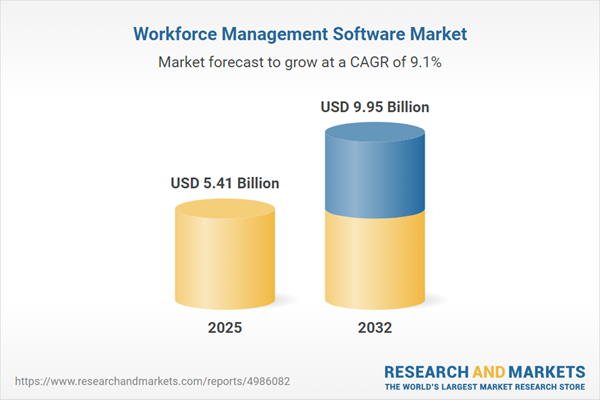Speak directly to the analyst to clarify any post sales queries you may have.
Workforce management software is quickly establishing itself as a core driver of organizational adaptability, empowering senior leaders to navigate regulatory shifts and workforce changes with data-driven confidence.
Market Snapshot: Workforce Management Software Market
The global workforce management software market is experiencing steady expansion, bolstered by the ongoing digitalization of core business functions. As enterprises automate repetitive administrative tasks, they are able to enhance operational efficiency and better meet evolving workforce needs. Market leaders are prioritizing integrated workforce management solutions that enable advanced talent allocation and compliance, alongside improved transparency for team performance. The adoption of these platforms is reinforcing business continuity, equipping organizations to adapt proactively to operational changes. Within this landscape, workforce management software is emerging as a foundational component of resilient, digital-first business strategies.
Scope & Segmentation
- Feature Set: Absence and leave management, precise time tracking, analytics, and intelligent scheduling tools enable regulatory compliance and optimize resource management across diverse industry sectors.
- Deployment Options: Public cloud, private cloud, and on-premises solutions provide organizations with scalable, compliant deployment choices, accommodating varying control and data residency preferences.
- Organization Scale: Solutions are designed to support large enterprises, midsize businesses, and small organizations, ensuring that diverse staffing models and operational complexities are effectively managed.
- Industry Applications: Customization addresses the unique needs of banking, public sector, manufacturing, healthcare, and retail, enabling organizations to align processes and meet regulatory standards specific to their sectors.
- Geographic Focus: Coverage in North America, South America, Europe, the Middle East and Africa, and Asia-Pacific supports region-specific compliance and business expectations.
- Leading Providers: Vendors such as Automatic Data Processing, The Ultimate Kronos Group, Oracle, SAP SE, Workday, Ceridian HCM Holding, NICE Ltd., IBM, Verint Systems, and Zebra Technologies continue to refine their platforms for evolving workforce environments.
Key Takeaways for Senior Decision-Makers
- Analytics-driven platforms generate actionable workforce insights, supporting real-time resource allocation and agile responses to changing labor demands.
- AI and machine learning enhance scheduling automation and flag compliance exposures, streamlining complex labor oversight tasks.
- Cloud-native and mobile solutions facilitate seamless management of remote and hybrid teams, maintaining business continuity when operational models shift.
- Automated compliance capabilities reduce manual workloads and support quicker adaptation to revised regulatory requirements, which is especially beneficial in sectors with frequent policy changes.
- Unified solutions integrating time, payroll, and talent management allow for organization-wide efficiency and enhanced cross-functional control.
- Ongoing vendor innovation ensures organizations remain aligned with emerging workforce policies and practices across different regions.
Tariff Impact: Navigating 2025 Cost Structures
Changing software and hardware tariffs are prompting reevaluation of workforce management technology investments. Many organizations are adopting cloud-based models to control upfront costs and increase operational flexibility. For companies with strict compliance or data sovereignty goals, private cloud deployments are gaining favor. Modular and bundled platform packages are also supporting predictable expenditure and regulatory adaptability, directing organizations toward compliance-focused, long-term investment plans for workforce management technology.
Technology & Regional Influences
The adoption of workforce management software reflects regional technology trends and compliance priorities. In the Americas, flexible regulations foster the uptake of cloud solutions and advanced analytics. Across Europe, the Middle East, and Africa, stricter governance requires customized software and robust privacy controls to address heightened data protection standards. Meanwhile, the Asia-Pacific region is rapidly shifting toward mobile-first and subscription-based workforce management, mirroring fast-changing business expectations and fiscal strategies. Understanding these dynamics is crucial for organizations seeking effective technology solutions suited to both multinational and local demands.
Methodology & Data Sources
This market analysis synthesizes insights from expert interviews, comprehensive regulatory reviews, and broad-based research. Findings are reviewed through established research protocols, ensuring that senior decision-makers access reliable, actionable perspectives.
Why This Report Matters
- Enables senior executives to align workforce management strategies with broader business transformation and operational resilience objectives.
- Accelerates adoption of advanced, AI-powered, and cloud-native tools for managing distributed and hybrid teams efficiently.
- Clarifies actionable pathways to manage compliance risk and adapt to regulatory and labor market changes as they arise.
Conclusion
Workforce management software enhances efficiency, simplifies regulatory compliance, and supports organizational agility. Strategic adoption of these platforms positions leaders to drive progress in an evolving business landscape.
Additional Product Information:
- Purchase of this report includes 1 year online access with quarterly updates.
- This report can be updated on request. Please contact our Customer Experience team using the Ask a Question widget on our website.
Table of Contents
3. Executive Summary
4. Market Overview
7. Cumulative Impact of Artificial Intelligence 2025
Companies Mentioned
The companies profiled in this Workforce Management Software market report include:- Automatic Data Processing, Inc.
- The Ultimate Kronos Group, Inc.
- Oracle Corporation
- SAP SE
- Workday, Inc.
- Ceridian HCM Holding Inc.
- NICE Ltd.
- International Business Machines Corporation
- Verint Systems Inc.
- Zebra Technologies Corporation
Table Information
| Report Attribute | Details |
|---|---|
| No. of Pages | 182 |
| Published | November 2025 |
| Forecast Period | 2025 - 2032 |
| Estimated Market Value ( USD | $ 5.41 Billion |
| Forecasted Market Value ( USD | $ 9.95 Billion |
| Compound Annual Growth Rate | 9.1% |
| Regions Covered | Global |
| No. of Companies Mentioned | 11 |









